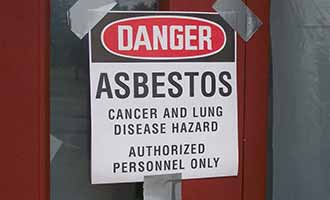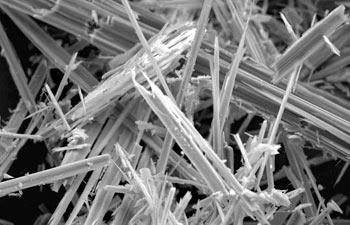 causes serious diseases and death. Although people have likely heard of asbestos and the diseases it causes, like mesothelioma, they may not be aware of all its dangers. Asbestos is an on-going problem, which will continue to inflict pain and suffering until its use in products is prohibited.
causes serious diseases and death. Although people have likely heard of asbestos and the diseases it causes, like mesothelioma, they may not be aware of all its dangers. Asbestos is an on-going problem, which will continue to inflict pain and suffering until its use in products is prohibited.
Asbestos is a naturally occurring mineral, which forms fibers. There are three types of asbestos found throughout the world. It is used in building materials, such as insulation. Millions of tons of asbestos have been used in industrial sites, homes, mills, factories, schools, shipyards and commercial buildings. Asbestos fibers are inhaled through the air. Most people are exposed while working and never know it. Even family members of workers may be affected as asbestos fibers can be transported on clothing. The dangerous side effects of asbestos has been known for years. In the early 1900’s, doctors were beginning to notice the connections between asbestos dust inhalation and the death of industrial workers. By now, the evidence is undisputed about the dangers of asbestos. It has been linked to many devastating illnesses.
 Asbestosis is a benign, non-cancerous disease caused by asbestos. The fibers of the asbestos are inhaled through the air and cause irritation to lung tissue. The asbestos fibers cause scarring and inflammation of the lungs. This can lead to breathing difficulties, including respiratory failure. Unfortunately asbestosis can also lead to mesothelioma and lung cancer. Other complications include tuberculosis, inflammation of the tissue lining the lungs (pleurisy) and heart failure.
Asbestosis is a benign, non-cancerous disease caused by asbestos. The fibers of the asbestos are inhaled through the air and cause irritation to lung tissue. The asbestos fibers cause scarring and inflammation of the lungs. This can lead to breathing difficulties, including respiratory failure. Unfortunately asbestosis can also lead to mesothelioma and lung cancer. Other complications include tuberculosis, inflammation of the tissue lining the lungs (pleurisy) and heart failure.
Mesothelioma is a cancer caused by asbestos exposure. Mesothelioma has a latency period of 20-50 years, meaning you could be exposed to asbestos in 1960 and could still develop cancer in 2010. Due to this extremely long time period, it is estimated there will be roughly 250,000 cases of mesothelioma before 2020. Mesothelioma can be treated with surgery, which involves the removal of the cancer, chemotherapy or radiation. Mesothelioma is an unusual cancer because it is not caused by cigarette smoking, but caused by asbestos exposure. Asbestos exposure has also be linked to other cancers including: larynx cancer, upper throat cancer, kidney cancer, esophageal cancer and cancer of the gall bladder.
 Asbestos exposure can also cause problems in the lungs, lung cancer and pleural disease. The latency period for lung cancer is between 20-30 years. It has been shown that cigarette smokers who are exposed to asbestos are more likely to develop lung cancer than a person who is either a cigarette smoker or exposed to asbestos. Pleural lung disease is caused by asbestos exposure affecting the lining of the lungs. The asbestos fibers cause scarring of the lungs and pleural calcification. Pleural calcification is calcium deposits in the areas of the lung where there was damage. The lining of the lung can also thicken and affect the ability of the lung to expand, which impairs breathing.
Asbestos exposure can also cause problems in the lungs, lung cancer and pleural disease. The latency period for lung cancer is between 20-30 years. It has been shown that cigarette smokers who are exposed to asbestos are more likely to develop lung cancer than a person who is either a cigarette smoker or exposed to asbestos. Pleural lung disease is caused by asbestos exposure affecting the lining of the lungs. The asbestos fibers cause scarring of the lungs and pleural calcification. Pleural calcification is calcium deposits in the areas of the lung where there was damage. The lining of the lung can also thicken and affect the ability of the lung to expand, which impairs breathing.
Even knowing all of the dangers associated with asbestos and how people are exposed, the federal government has not done enough to lower exposure levels. In 1989, the U.S. Environmental Protection Agency (EPA) did pass an Asbestos Ban & Phase Out Rule. The rule banned most asbestos containing products. But only two years later, the rule was overturned in a courtroom proceeding. However, there has been some success. Some asbestos containing products are banned: roll board, flooring felt and corrugated, commercial and specialty paper. Any new products, those that did not historically contain asbestos, are also banned.
 But why hasn’t the government done more? Current estimates the cost of asbestos litigation in the U.S. is $250 billion. Even the financial cost, much less the human cost has not prompted a complete asbestos ban. Asbestos containing materials are still being used in the United States. The U.S. Occupational Safety and Health Administration (OSHA) has established a permissible asbestos exposure level for workers and other safety measures to reduce exposure, such as protective clothing, labeling and record keeping of exposure. Nevertheless, with new advances in technology, it seems we could find an asbestos substitute that doesn’t have these dangerous side effects. We have known about the dangerous of asbestos for almost 100 years, what does it take for the government to realize a complete asbestos ban is necessary to protect the health and safety of U.S. workers?
But why hasn’t the government done more? Current estimates the cost of asbestos litigation in the U.S. is $250 billion. Even the financial cost, much less the human cost has not prompted a complete asbestos ban. Asbestos containing materials are still being used in the United States. The U.S. Occupational Safety and Health Administration (OSHA) has established a permissible asbestos exposure level for workers and other safety measures to reduce exposure, such as protective clothing, labeling and record keeping of exposure. Nevertheless, with new advances in technology, it seems we could find an asbestos substitute that doesn’t have these dangerous side effects. We have known about the dangerous of asbestos for almost 100 years, what does it take for the government to realize a complete asbestos ban is necessary to protect the health and safety of U.S. workers?


